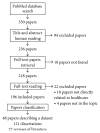Toward a Literature-Driven Definition of Big Data in Healthcare
- PMID: 26137488
- PMCID: PMC4468280
- DOI: 10.1155/2015/639021
Toward a Literature-Driven Definition of Big Data in Healthcare
Abstract
Objective: The aim of this study was to provide a definition of big data in healthcare.
Methods: A systematic search of PubMed literature published until May 9, 2014, was conducted. We noted the number of statistical individuals (n) and the number of variables (p) for all papers describing a dataset. These papers were classified into fields of study. Characteristics attributed to big data by authors were also considered. Based on this analysis, a definition of big data was proposed.
Results: A total of 196 papers were included. Big data can be defined as datasets with Log(n∗p) ≥ 7. Properties of big data are its great variety and high velocity. Big data raises challenges on veracity, on all aspects of the workflow, on extracting meaningful information, and on sharing information. Big data requires new computational methods that optimize data management. Related concepts are data reuse, false knowledge discovery, and privacy issues.
Conclusion: Big data is defined by volume. Big data should not be confused with data reuse: data can be big without being reused for another purpose, for example, in omics. Inversely, data can be reused without being necessarily big, for example, secondary use of Electronic Medical Records (EMR) data.
Figures








References
Publication types
MeSH terms
LinkOut - more resources
Full Text Sources
Other Literature Sources
Medical
Miscellaneous

